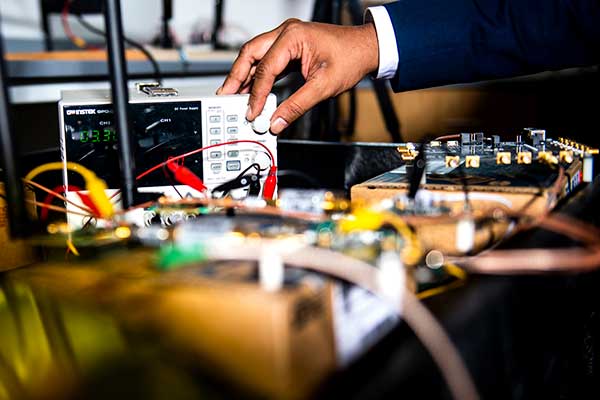Two Patents Issued for Naderi & Chowdhury Innovation

ECE Professor Kaushik Chowdhury and Research Assistant Professor Yousof Naderi were awarded patents for “Encoding and decoding data in communication frames of a communications protocol” and “Distributed wireless charging system and method.”
Encoding and decoding data in communication frames of a communications protocol
 This invention introduces a novel encoding scheme that changes the spatial positioning of Almost Blank Subframes (ABS) within a standard LTE frame to convey control information. This allows any number of ABS settings to be chosen by the LTE eNB and accordingly adjusts the encoding of control messages at maximum possible transmission rates. Additionally, a session management protocol is disclosed to maintain contextual information of the control signaling. This allows the system to handle situations where the control message may span multiple frames, or when the LTE operator temporarily reduces the number of ABS. On the other hand, the IoT receivers, such as sensors, Internet of Things (IoT) enabled appliances, and mobile/wearable equipment that is coupled with this wake-up module may decode the overlaid control information within the LTE bands. The module itself is composed of an adaptive decoder and an RF energy harvester circuit with high sensitivity. Error detection and correction mechanism are introduced to counter channel and fading errors are incorporated.
This invention introduces a novel encoding scheme that changes the spatial positioning of Almost Blank Subframes (ABS) within a standard LTE frame to convey control information. This allows any number of ABS settings to be chosen by the LTE eNB and accordingly adjusts the encoding of control messages at maximum possible transmission rates. Additionally, a session management protocol is disclosed to maintain contextual information of the control signaling. This allows the system to handle situations where the control message may span multiple frames, or when the LTE operator temporarily reduces the number of ABS. On the other hand, the IoT receivers, such as sensors, Internet of Things (IoT) enabled appliances, and mobile/wearable equipment that is coupled with this wake-up module may decode the overlaid control information within the LTE bands. The module itself is composed of an adaptive decoder and an RF energy harvester circuit with high sensitivity. Error detection and correction mechanism are introduced to counter channel and fading errors are incorporated.
Distributed wireless charging system and method
 In this invention, a controllable, programmable distributed wireless radio frequency (RF)-based charging system and method are described. The hardware platform includes programmable energy transmitters (ETs) and adaptive energy harvesters coupled with energy-receiving target devices.
In this invention, a controllable, programmable distributed wireless radio frequency (RF)-based charging system and method are described. The hardware platform includes programmable energy transmitters (ETs) and adaptive energy harvesters coupled with energy-receiving target devices.
Under the software control, the energy transmitters cooperatively form focused beams of energy to transmit power to a set of target devices using radio frequencies within, for example, a license-free industrial, scientific and medical (ISM) band. The energy-receiving target devices, such as sensors, Internet of Things (IoT) enabled appliances, and mobile and/or wearable equipment, are coupled with the adaptive energy harvesters to utilize the energy contained within the transmitted beams, as well as ambient RF sources, for directly powering their operation or for charging a battery and/or capacitor for subsequent use.